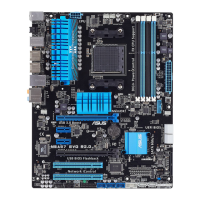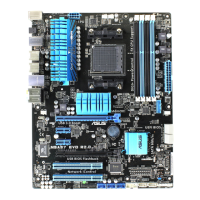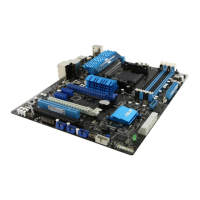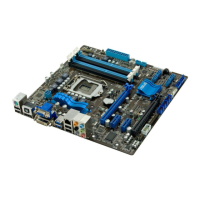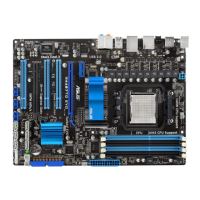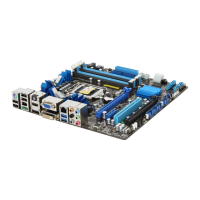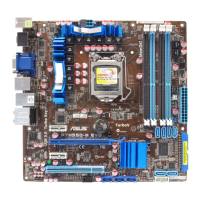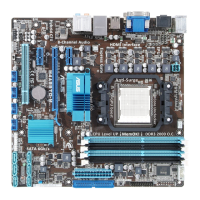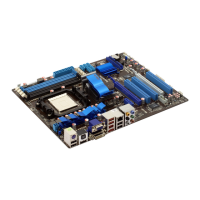Do you have a question about the Asus M5A88-M EVO and is the answer not in the manual?
Welcomes the user to the motherboard.
Lists items included in the motherboard package for installation.
Highlights the motherboard's key technologies and capabilities.
Details the core features like CPU, memory, and connectivity support.
Describes proprietary ASUS technologies enhancing performance and usability.
Essential precautions before installing hardware components to prevent damage.
Visual guide to the motherboard layout, connectors, and slots.
Guidance on correctly orienting the motherboard within the chassis.
Identifies specific points for securing the motherboard to the chassis.
Illustrates the physical layout of all major components and connectors.
Detailed explanation of each connector, jumper, and slot on the motherboard.
Instructions for installing and configuring the CPU.
Step-by-step guide for securely installing the CPU into its socket.
Procedures for mounting the CPU heatsink and fan assembly.
Information on installing and configuring DDR3 memory modules.
Introduces the motherboard's DDR3 DIMM sockets and memory capabilities.
Details memory module compatibility, capacities, and guidelines.
Step-by-step instructions for inserting a memory module into a DIMM socket.
Step-by-step instructions for removing a memory module from a DIMM socket.
Information on installing and configuring expansion cards.
Procedures for physically installing an expansion card into a slot.
Steps to configure installed expansion cards via BIOS and drivers.
Description of the PCI slot's function and supported devices.
Details the PCI Express x1 slots and their applications.
Description of the PCI Express x16 slot for graphics cards.
Explanation of the Clear RTC RAM jumper and its function.
Details all connectors on the motherboard for system components.
Description of all external connectors on the motherboard's rear panel.
Details all internal connectors for system components and headers.
Explains the status and function of the motherboard's onboard LEDs.
Description of onboard switches for performance tuning and system features.
Information on installing operating systems and using the support DVD.
Guidance on OS installation for optimal compatibility and system stability.
Details the contents and usage of the motherboard's support DVD.
Methods for managing, backing up, and updating the system BIOS.
Utility for BIOS management and updates within the Windows environment.
Tool for updating BIOS directly from within the BIOS setup.
Recovery tool to restore a corrupted BIOS file automatically.
Utility for updating BIOS in a DOS environment, including backup.
Guide to entering and navigating the BIOS setup utility.
Overview of the BIOS setup interface, including menu bar and navigation.
Displays basic system information and initial BIOS settings.
Allows adjustment of the system's current time and date.
Configuration of SATA devices, including RAID setup and device type.
Displays detected BIOS, Processor, and System Memory details.
Settings for CPU and memory overclocking and performance tuning.
Options for selecting CPU overclocking profiles or manual settings.
Fine-tunes memory timings for optimal performance and stability.
Adjusts CPU, NB, DRAM, and other voltages for tuning.
Configures CPU Load-Line calibration for voltage stability.
Configures CPU/NB Load-Line calibration for voltage stability.
Settings for CPU, Chipset, and other system devices.
BIOS settings related to CPU features like SVM, Cool'n'Quiet, and Core Unlocker.
Configuration options for the Northbridge, DRAM controller, and graphics.
Settings for integrated peripherals like audio, LAN, serial, and parallel ports.
Settings for PCI/PnP devices, including IRQ and DMA channel assignments.
Configuration options for USB functions, legacy support, and controller modes.
Settings for ACPI and APM for system power management.
Configures system suspend states, ACPI, and APM features.
Displays hardware monitoring info like temperatures, voltages, and fan speeds.
Enables surge protection and NB thermal protection for safety.
Options for configuring the system's boot sequence and behavior.
Sets the sequence of devices from which the system will attempt to boot.
Configures boot settings like Quick Boot and full screen logo display.
Manages BIOS passwords, user access levels, and system security.
Access to special utilities for system management and performance.
Utility for flashing the BIOS directly from within the BIOS setup.
Allows saving and loading custom BIOS settings profiles.
Options to save, discard, or load BIOS settings and exit the setup utility.
| Form Factor | Micro ATX |
|---|---|
| Chipset | AMD 880G |
| CPU Socket | AM3+ |
| Memory Slots | 4 x DIMM |
| Maximum Memory | 16GB |
| Memory Type | DDR3 |
| PCI Express x16 | 1 |
| PCI Express x1 | 2 |
| PCI Slots | 1 |
| SATA 3Gb/s | 5 |
| SATA 6Gb/s | 1 |
| USB 3.0 | 2 |
| Integrated Graphics | ATI Radeon HD 4250 |
| Audio | Realtek ALC892 8-Channel High Definition Audio CODEC |
| LAN | Realtek 8111E Gigabit LAN controller |
| RAID Support | RAID 0, 1, 5, 10 |
| USB Ports | 12 |


